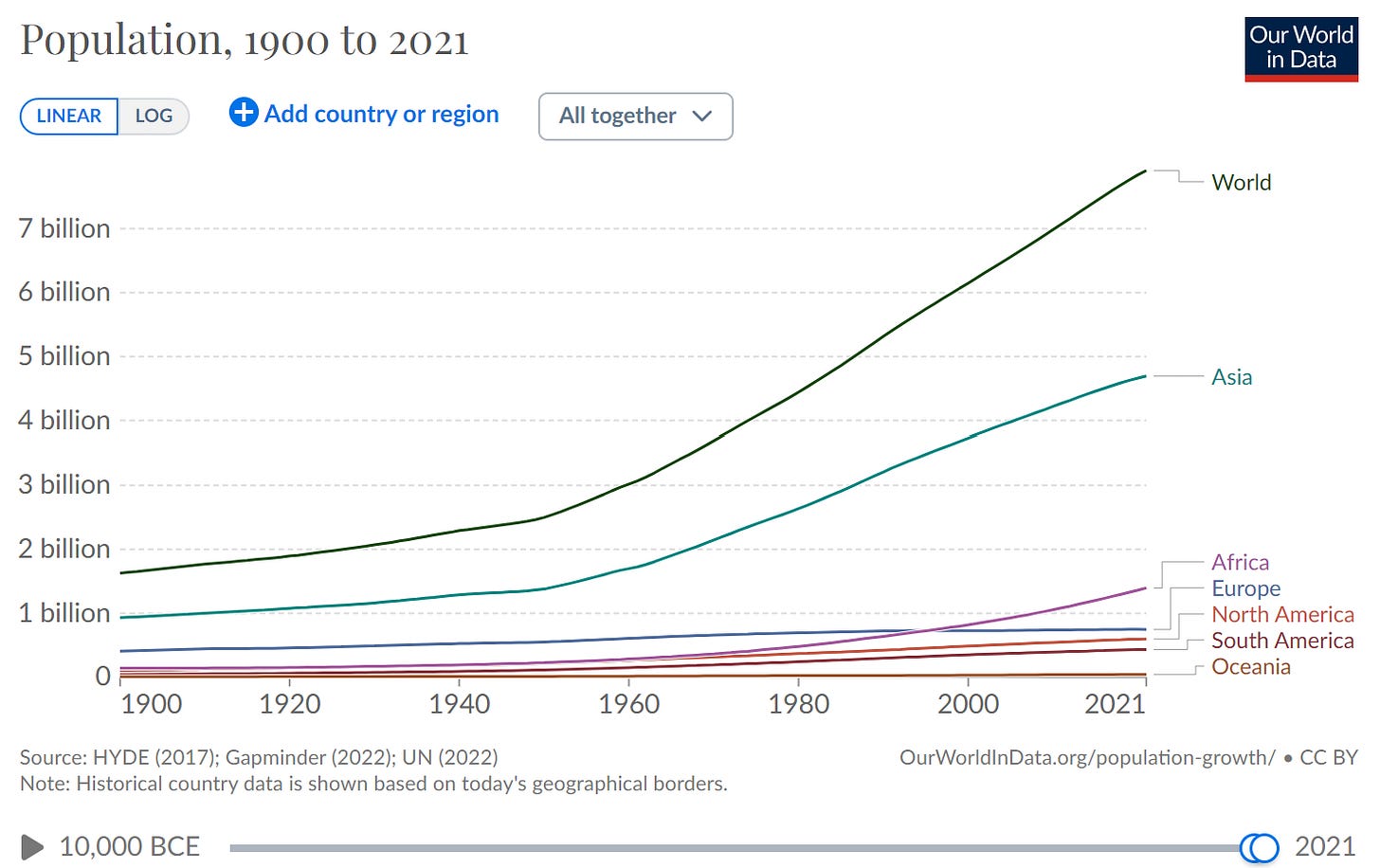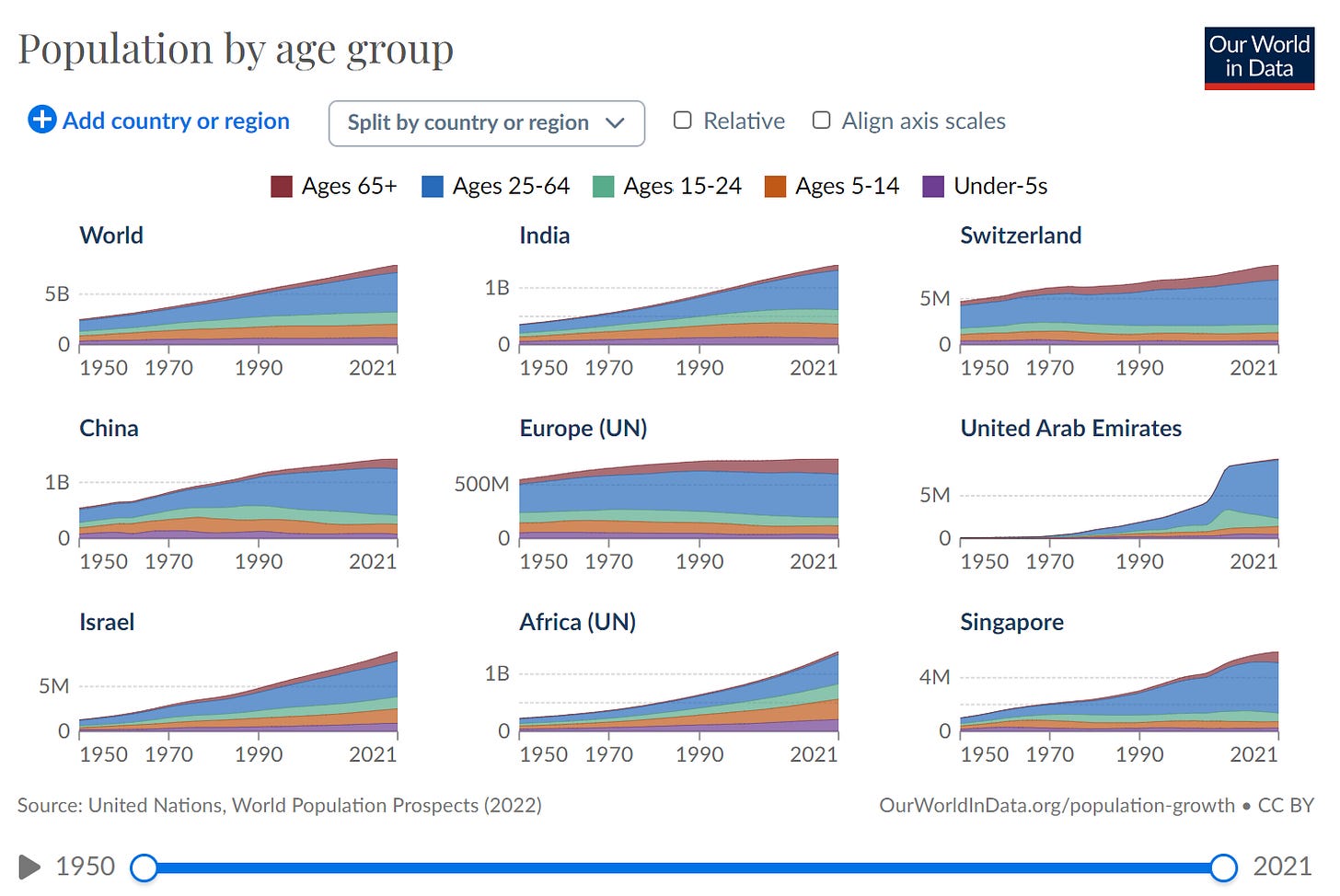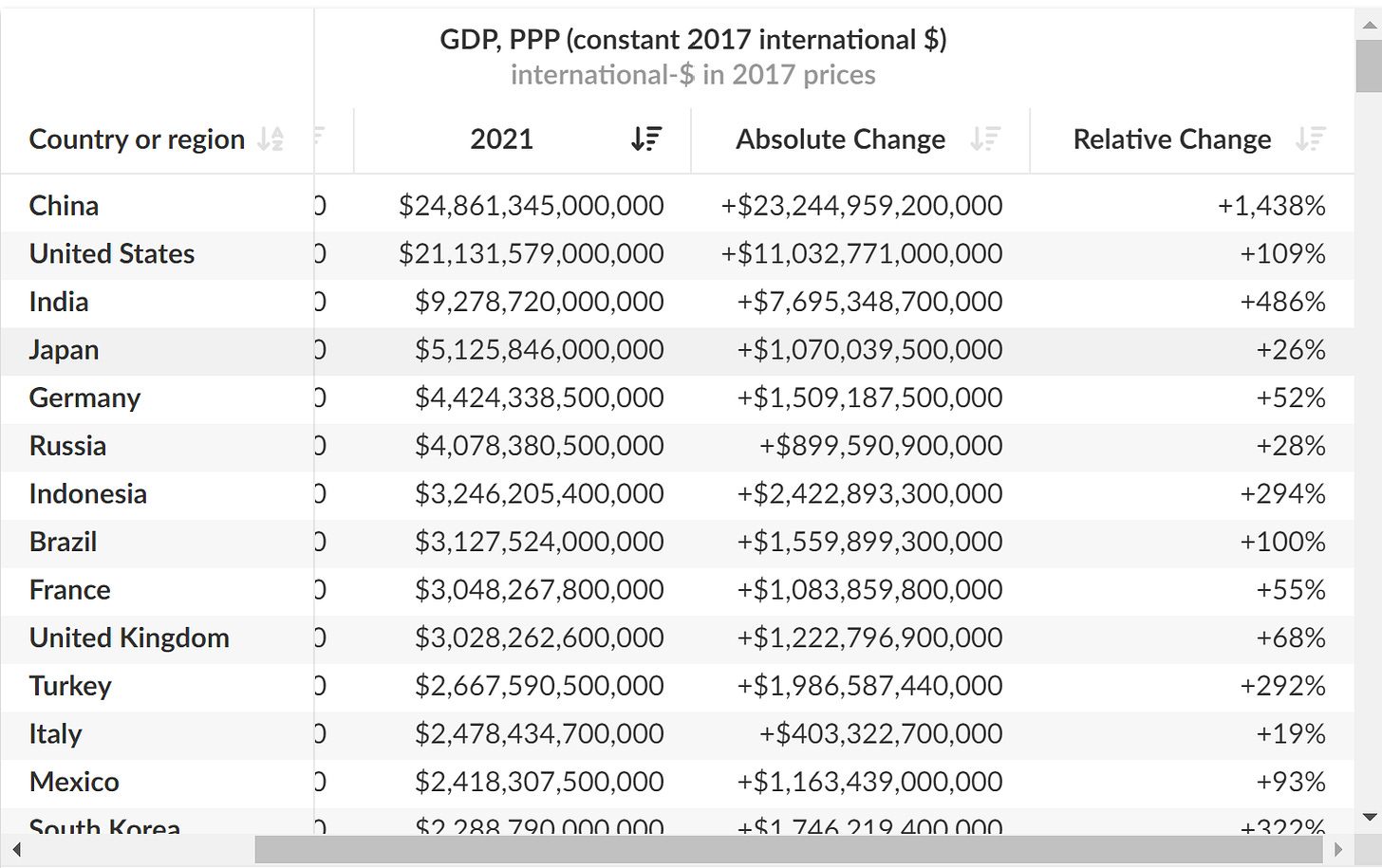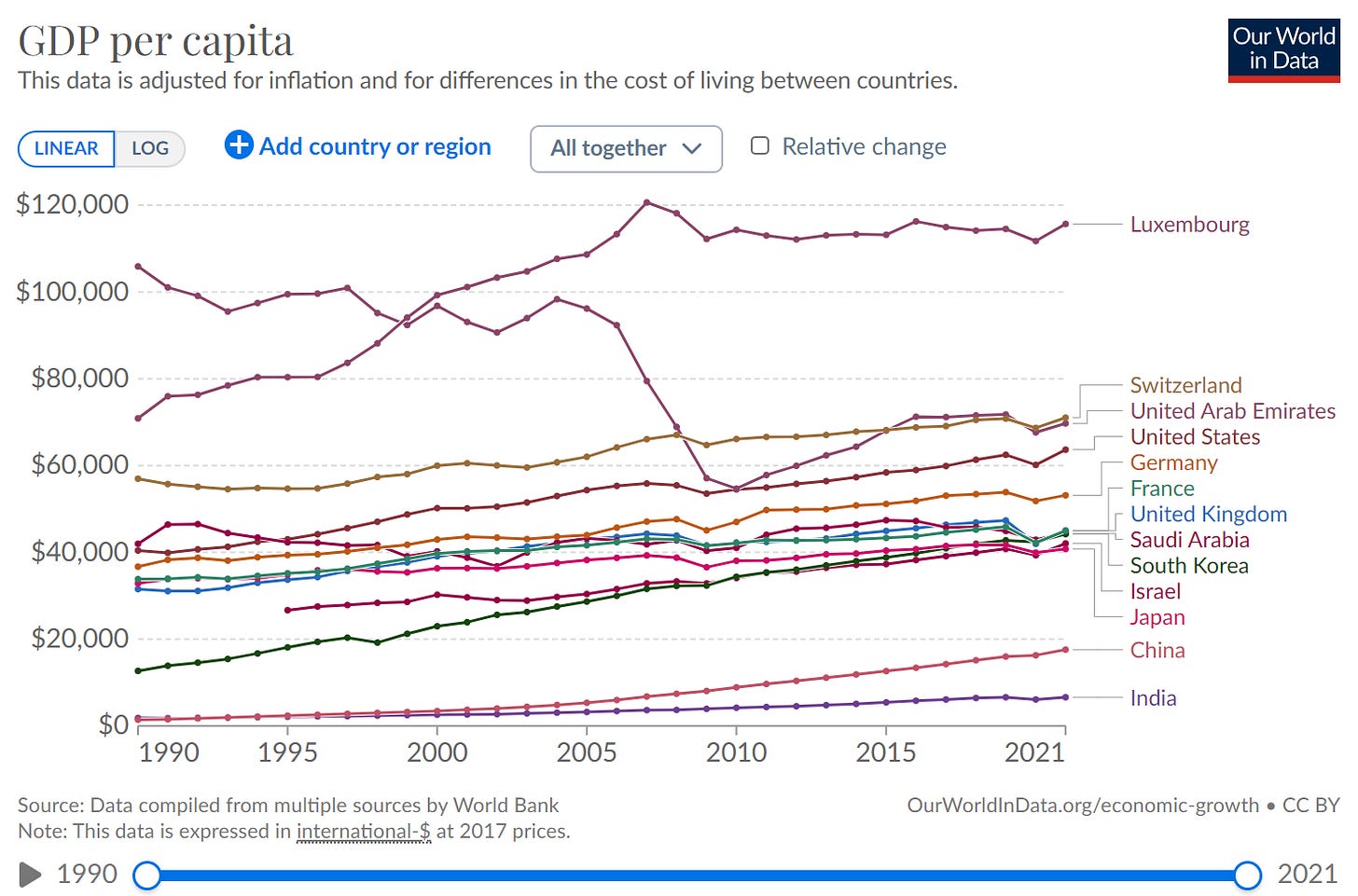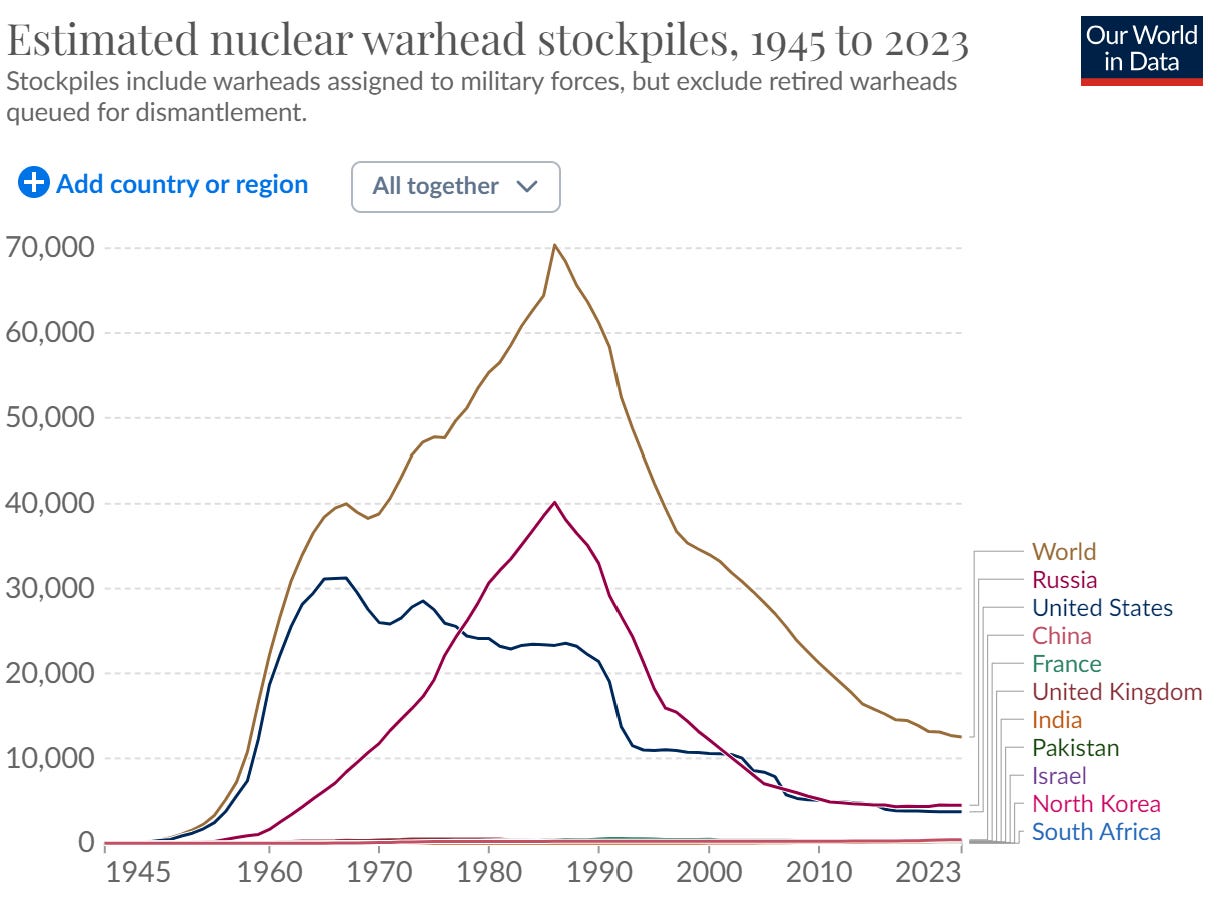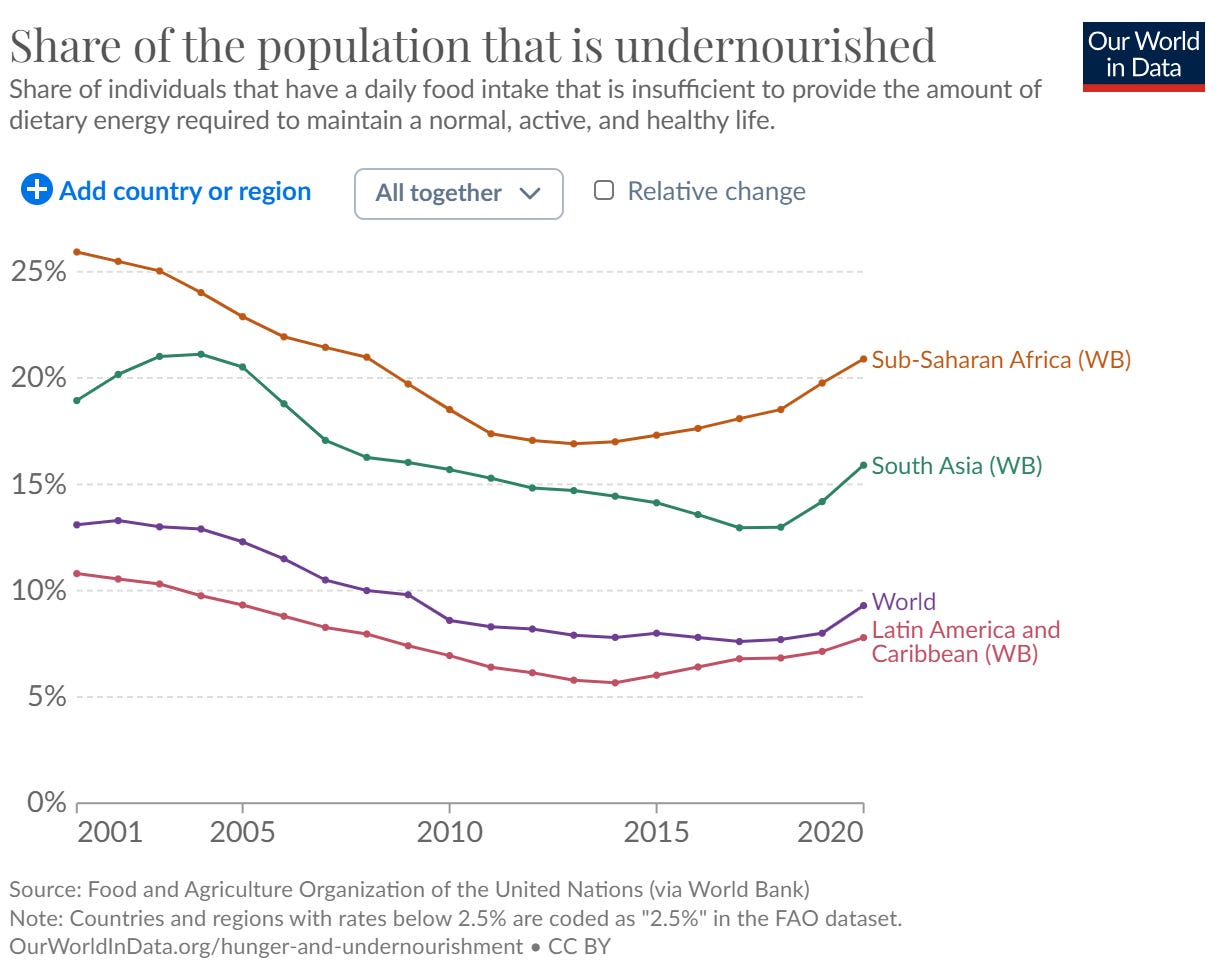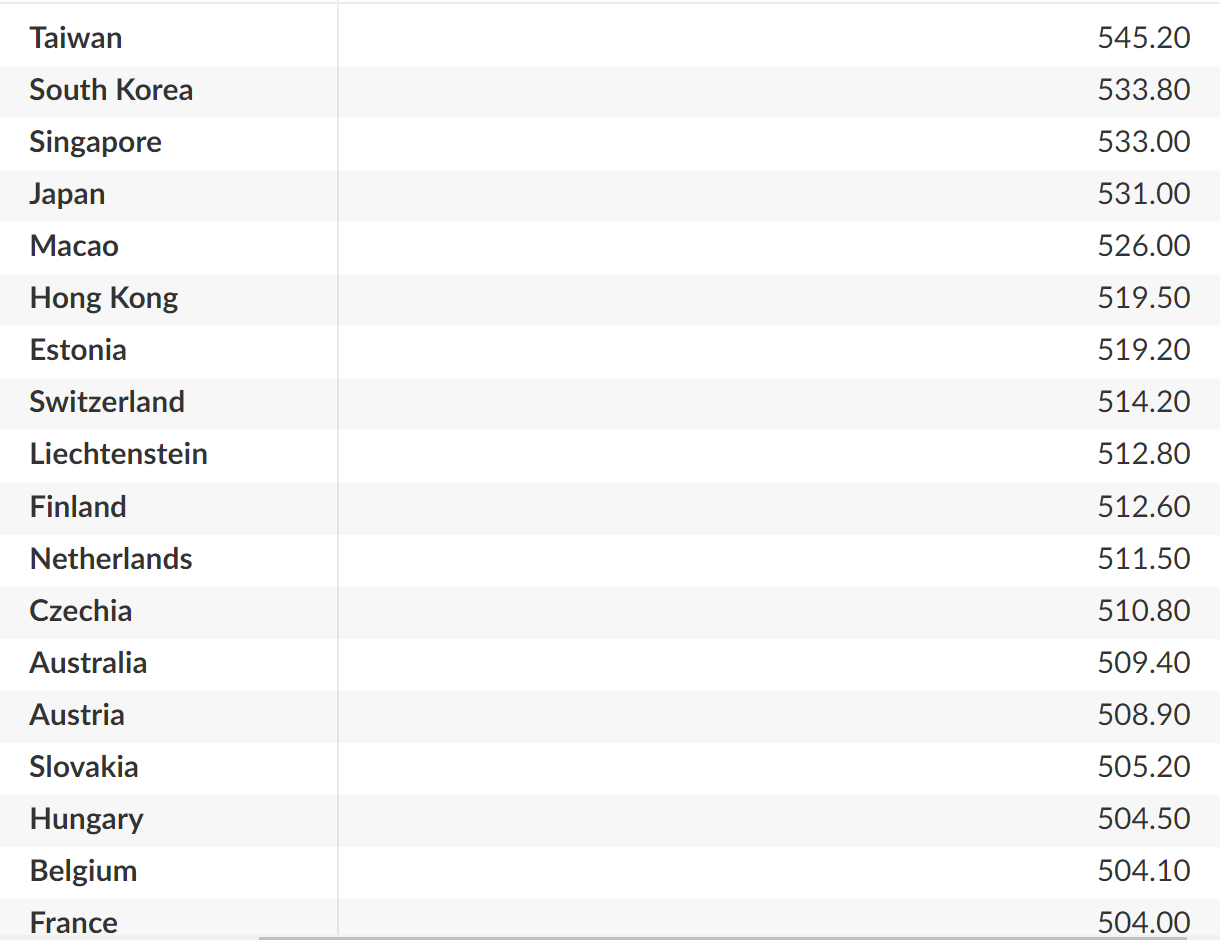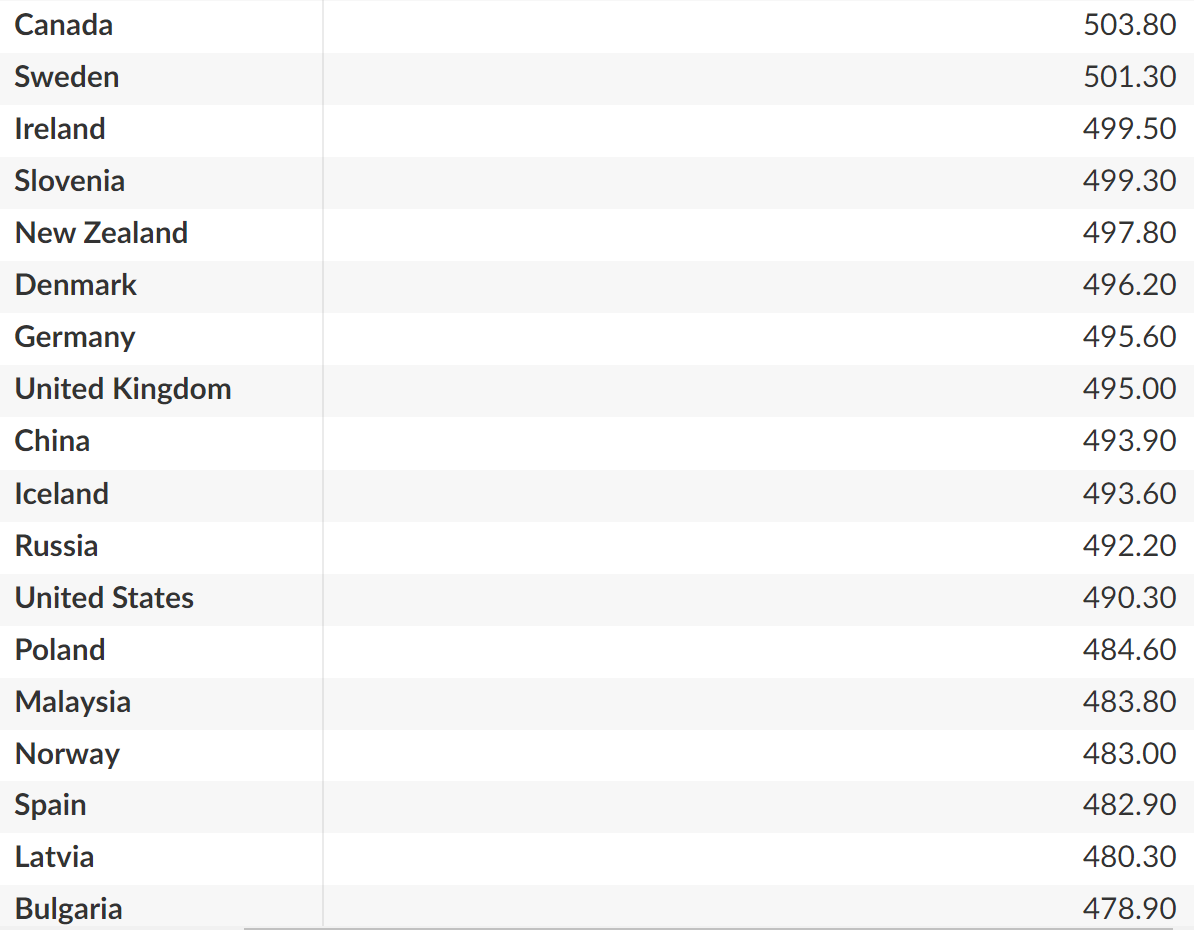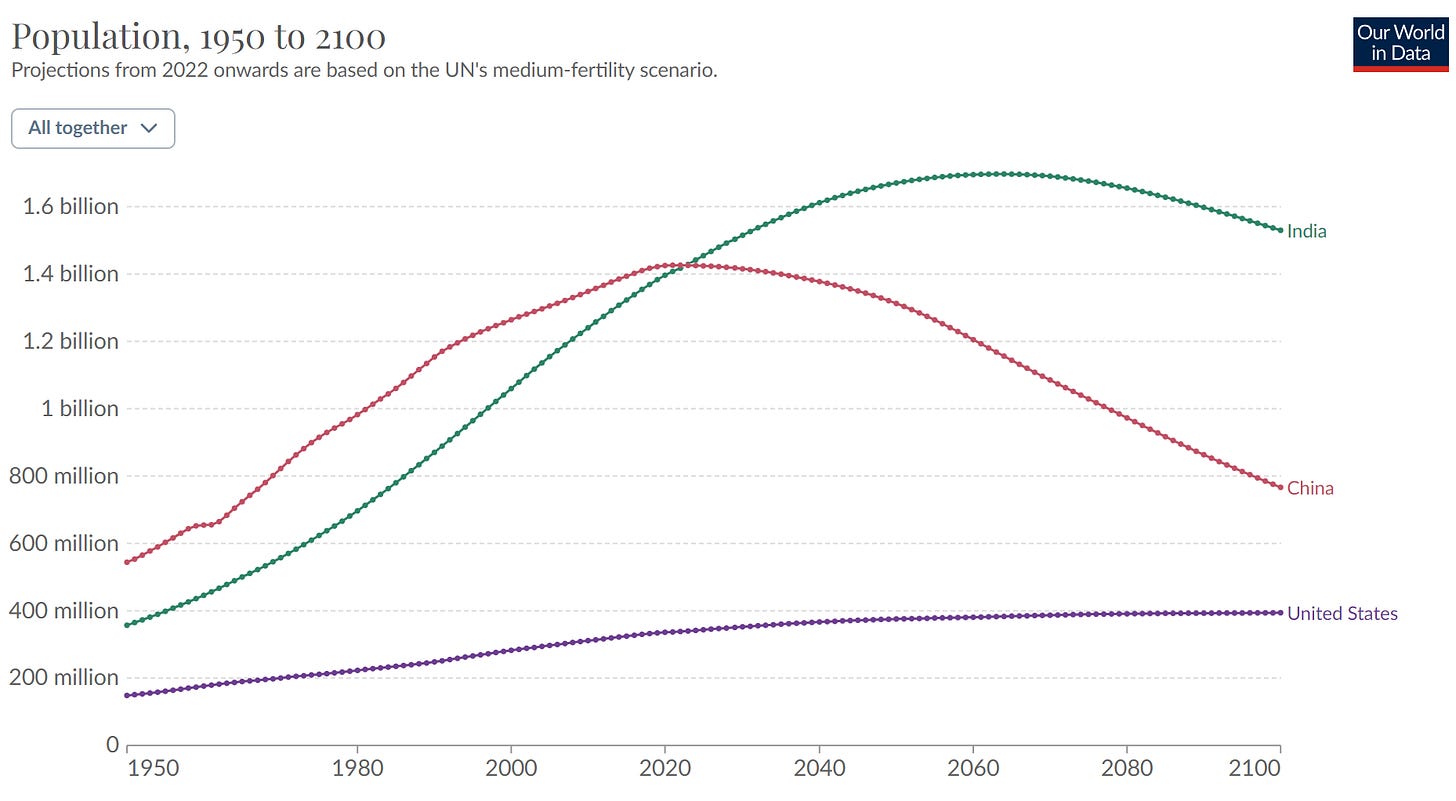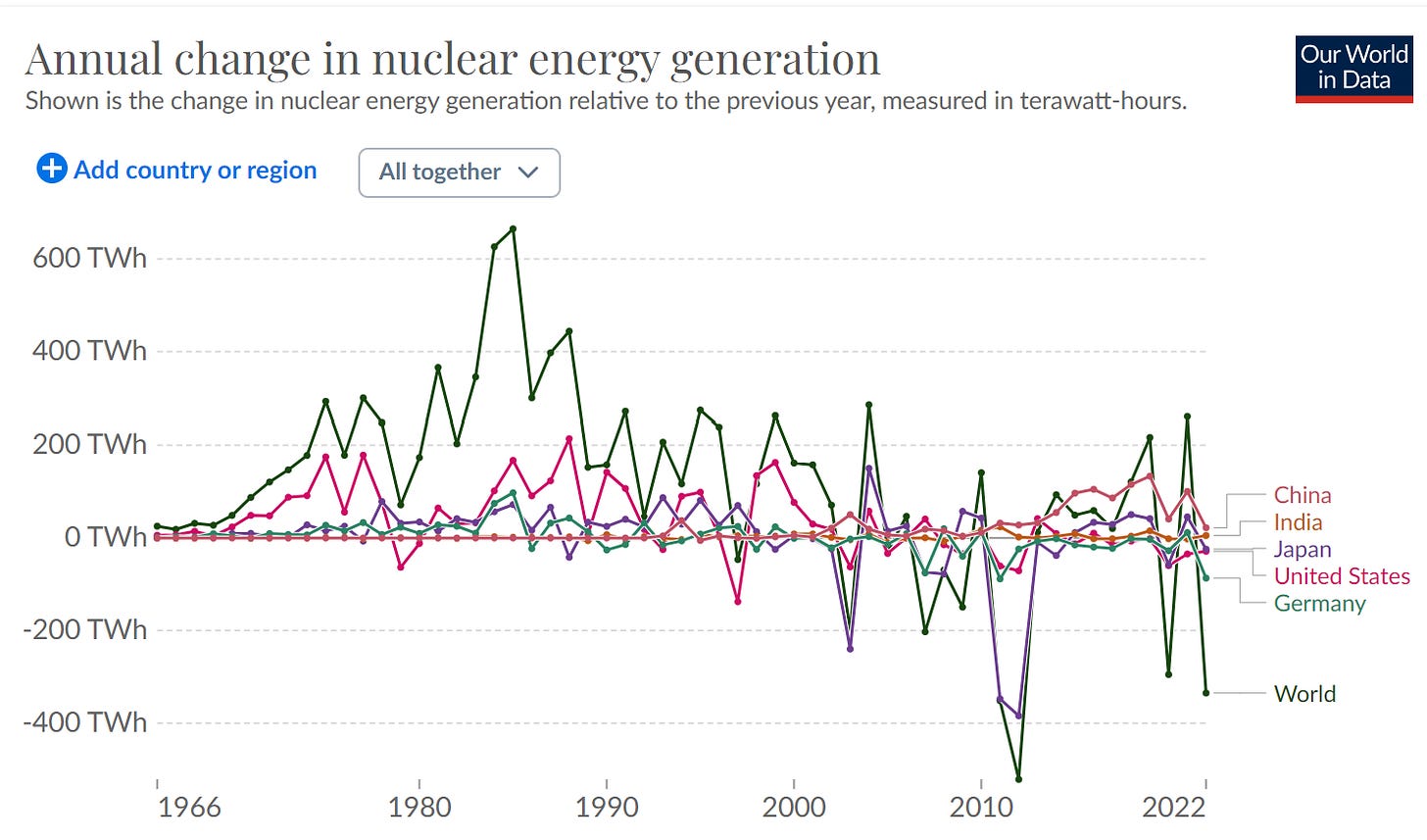Predicting Change, the Most Valuable Thing in the World
(This post is a draft that I’ve written for myself and wasn’t originally supposed to communicate ideas to a reader with no prior research of the discussed topics. You might still find something that is interesting to you in here, so there is only upside in publishing it. Also, Part.2 might be more interesting for most people.)
I joined a masters program, that presented a lot of problems but did not give many convincing answers. I knew I cared about my family and friends and their future. I wanted to make sure that my path would guarantee a great future for these people. I set up to find out what I should do, and the first step was to understand. I needed to understand how to think about the world and to build a mental framework that I could use in the future, no matter the situation I would find myself in. Here is what I’ve understood: predicting change is the most valuable thing in the world. And what follows is me laying out reflections and ideas that led me to that understanding. Imagine this to be a framework that guides you to build a prosperous life over the next 100 years.
Part.1: How to think about value
The most certain way to survive is to be in a completely predictable environment.
For instance, consider the COVID-19 pandemic. The moment the virus started spreading, the safest way to not die was to isolate yourself in a bunker. No contact with anybody or anything outside that bunker. That would have been better than social distancing, wearing masks, wearing two masks, disinfecting your hands, or getting vaccinated. In other words, to be in a completely predictable environment.
The feeling corresponding to predictability is control.
Complete predictability feels like complete control, but having the feeling of complete control doesn’t mean that you environment is 100% predictable. The only way to find out whether your feeling of complete control is reliable is to make predictions and by doing so rely on data.
The feeling of control during the Covid-19 pandemic
No control: The most scared people, stayed home and didn’t see anyone. They ordered groceries to be delivered to them, spent their time facetiming and zooming instead of going out. Entertainment mostly happened online or with people that where part of their household. Essentials were ordered in mass.
Some control: The less scared people, those wo where mildly worried about survival wore masks, used disinfection spray or insisted on keeping some distance. They travelled less and did less social activities. Since restaurants where closed, expensive Covid tests or vaccinations where required to do anything and high fines where put in place in case the law was violated, they were forced to spend time in mildly controlled environments.
Complete control: Those who where not scared at all, were angry and were expressing that anger. COVID-19 did not feel like a threat to their environments. They felt in complete control and the changes that where put in place, social distancing, masks and vaccines actually felt like threats to them. Whether this fearlessness was justified is not the point here. The point is that these changes that were put in place felt more like a loss of control to these people then the COVID-19 measures themselves.
What these 3 groups of people had in common, was that their decisions of how to act were made based on their feeling of control. And feelings are subjective. In fact predicting what was going to happen during the pandemic was impossible. Because for prediction you need data and enough data was not available to the average person in any of these 3 groups.
The ones who tried to gather as much data as possible where good faith decision makers. These included researchers, advisors and politicians who needed to put in place measures and make critical decisions for specific regions and countries.
Making predictions using relevant data:
Looking back now the best strategy would have been for decision makers:
To look at similar cases of the past, past pandemics.
To know their countries/regions entirely, its economy, history, the people, their habits, the major causes of death, the age composition of the population, the incidences of smoking and air pollution, the prevalence of obesity, poverty and inequality, and the normal quality of health service delivery, etc. Countries or regions may differ in size and density. Considering all these variables would lead to better judgement.
To use the judgment: Decision makers should appropriately and confidently use their own data, research and judgement while using continuous monitoring. They should show patience, flexibility, intelligence in their decision making.
I do not believe that it makes much sense now, to look at different countries and say that they made better decisions and that these decisions should have been applied to other countries. Maybe they should have looking at it now but at the time that wouldn’t have been the right strategy and a big gamble.
We can however identify which countries did a good job and which countries did a poor job at setting policies without saying this and that should have been done differently.
To do that we look at excess deaths in different contexts. Since, the job of a decision maker is to protect all its people, it is in a way irrelevant what people died off, a car accident, a stroke, HIV or COVID-19. During the pandemic, government action should therefore have been taken considering all people and all possible causes of death.
Throughout what follows you will see that we could have done better. Roughly, an extra 10million people had to die during the pandemic. Estimates from the WHO and the Economist (Image 1) are even higher than that. These numbers do not show however what the causes of death were (Image 2). It simply shows the cumulative excess deaths, due to any causes of death.
Conclusion, since the role of decision makers is to protect all its people, their actions or inactions did kill people. Let’s see how well individual governments did.
Some governments did perform better than others. It is interesting to see by looking at Sweden, that some countries did not need long lockdowns and mandatory masks in order to keep a low excess death rate. This does not mean however, that the US should have done the same, as many claim. These are different countries who necessitated different government action. This also doesn’t mean that the actions to take for each government where obvious or equally hard to decide on for all of them. Good governments are those who did good predictions by using data, and there best judgement. In a similar fashion that I presented previously. The better the predictions the more people survived.
It is hard to put a value on the actions a government took but I assume that actions who saved lives are pretty valuable to people. We can also value the human drive to survive in a different way. To do that we have to answer the question:
Who aims to “survive”?
During the pandemic it was people who needed to survive but we have to dig deeper, what are people made of?
I’ve talked about what it means to exist and therefore to survive extensively before, for example in this article. In brief, it means that to be you, and to remain you, you need certain things. That applies to the biological you as well as to the psychological you; your thoughts, believes and values.
The biological you has needs. Some of the most basic biological needs: Breath, eat, sleep.
The psychological you also has needs. Some of the most basic psychological needs: repetition, confirmation, reminders, experiences, proof.
If these needs are not met the psychological and/or the biological you might not survive. In fact psychological and biological are not distinct and as defined. They also change every time they interact with something external. Every time you eat something your body changes. Every time you watch the news, your perception of the world changes a tiny bit. The impact and permanence of these changes depends on the kind of interaction you’ve had.
In a world where you can’t know everything about your environment, survival means to act in a way that favours the chance of what I consider to be me to keep being around in the future. Every action I take is just my best guess of what the best thing is for the current me to survive.
What do people need to survive?
Usually, what people need to survive changes slowly and therefore value also changes slowly. What people need is driven by external factors and external things also tend to change slowly.
Sometimes however things change quickly and you are forced into changing. Some parts of you die. Instead of being rich, you are suddenly less rich if interest rates rise quickly. Or instead of being free to go out, you are suddenly locked at home if a pandemic starts. Or instead of being an athlete, you are suddenly in wheelchair if you have a tragic accident. These significant changes, change who you are and ultimately what you need to survive.
When things change, what do people need?
Let’s deconstruct that question:
Who am I?
What is available to me?
What do I need to survive?
The thing I need to survive is valuable to me. The aggregate of what is valuable to people, is perceived as valuable by a whole, for example the market.
During the pandemic what did people value? And what did the market value?
Let’s answer that question using the previous questions.
Who am I? A person sitting at home staring at the screen, ordering food, I’m a little more anxious than usually. I feel like Covid-19 and lockdown is a part of my life now. I’m a bit in a nothing to loose mode. I’ve more time to pay attention to my feelings. I’m even more driven by my feelings than before. I don’t go to restaurants and I’m forced to buy masks, get tested. I can’t travel or go on holidays. My emotions tend to be more mixed, all over the place and more negative. I’m more neurotic as usual. I still have all that money to spend but less expenses than before. Interest rates are low I can still borrow cheaply. I can not go to the office and have to work from home.
What is available to me? My TV, my computer, my phone, money, Crypto, Netflix, Meta, Social media, the news, supermarkets, little outdoor place to work out, if at all. Other activities that I’m able to do at home. My kids and my family.
What do I need to survive?
I need to cover all my needs.
Some of them are covered in the same way as before the pandemic but some are covered differently due to the answers to the “Who am I?” question from above.
My physiological needs are met in a similar way, there are different ways to provide food, delivery instead of supermarket or delivery instead of going to the restaurant but overall it is quite the same.
My safety needs, are affected. I’m more worried, I buy more of everything just to be safe. I need more reassurance, more and clearer information of what’s happening. I need to stay healthy. I need masks. I stick even more to what I trusted in my life before Covid.
My social needs, are affected. I need to find different ways to connect with people. Digitally maybe?
My esteem needs and self actualization needs are affected. I need to show off what I can do, somewhere, somehow to someone. I need to do it online. I need to explore, understand, grow somehow. I need to do it online.
The thing I need to survive is valuable to me. The aggregate of what is valuable to people, is perceived as valuable by the market.
In the following graph you see how this change in needs is reflected through an increase in shareholder returns driven by an increase of the stock price and dividend pay-out. It becomes obvious how the change in needs for survival that we identified a moment ago are matching the increase in average shareholder return. Simply match how the new needs are fulfilled by the corresponding industries.
For instance, the need of spending time online to keep up social connections is matched with “high tech” and “advanced electronics”. The need to cling to things we trust is matched with the “Mega 25” (companies that were already trusted by their customers before the pandemic). The need for staying healthy is matched with “healthcare services”. This matching process can be done with all needs that emerged during the pandemic.
Conclusion, things that make you survive are highly valued, and we can quantify these, for instance, by looking at dynamics of the stock market during the pandemic.
Predicting change
Consider again that you and a few others locked themselves in bunkers at the start of the pandemic. Covid-19 turned out to kill everyone who wasn’t in a bunker cause they caught it and died. These bunkers would have been the most valuable things in the world.
You, the survivors, just happened to lock yourselves in bunkers by chance because you were scared or for whatever other reasons. What is for sure is that you had no clue that the pandemic would turn out this way. You couldn’t possibly have know. And therefore, you couldn’t have known that the bunker would turn out to be so valuable.
So what could possibly be even more valuable than the bunkers themselves? An approach that could have predicted that COVID-19 would kill everybody and that the only way to survive would be to wait in a bunker. In other words, predicting change.
Predicting change: the equivalent of power and control
What we want to predict
Predicting change is the ultimate tool for survival. And so, that’s where the most value can be found. Before defining the tool of prediction we need to define the thing we want to predict. Humans are able to control and predict most of their non-human environments already. The natural environment does not cause an unpredictable threat to humans anymore. We have power and control over our environment. Even climate change is not unpredictable anymore. We are aware of it and know that we have to create change. Similarly, pandemics are a threat but are way more predictable than they used to be, if not caused by humans.
As humans gather more and more power and control over their environments, the average human also has the possibility to gather more power and control over other humans. This means a single human could cause a significant threat to a large number of humans, through their actions and creations. Therefore the major element we want to control and be able to predict are simply humans and by doing that the change humans create.
Three sets of tools for prediction:
The separation of these tools into sets is not as clear as I will make it seem. Even within sets it is more of a spectrum than a defined set of equal tools.
The first set of tools predicts change through the passive observation of the human environment. There is a minimum impact between what we want to predict (humans) and the action of predicting. The only impact comes from the feedback loop that emerges between what we want to predict (humans) and the action of predicting. Examples are:
General prediction markets: averaging the believes and information of the crowed regarding all kinds of outcomes using financial incentives. ex: Polymarket
Stock market: averaging the believes and information of investors regarding the value of companies. Ex: Nasdaq
Quant funds: use algorithms to identify signals that tell whether to buy or sell. These algorithms allow Quantum funds to make better and quicker decisions in the markets. Even though they partly shape the market environment their impact remains minimal. Ex: Capital Fund Management
Tesla autopilot: an advanced driver assistance system allows the Tesla car to observe its environment while driving and take action based on the information it has gathered and what it has learned over time. The information it gathers is still limited and the actions it takes are limited to driving and very limited in terms of shaping the human environment.
The second set of tools predicts change by actively making and shaping the human environment. There is a medium impact between what we want to predict (humans) and the action of predicting. The medium impact comes from the direct interaction of humans and their environments. By shaping the environment we are able to impact humans and so partially predict their actions. It takes advantage of how humans act naturally in specific environments. Examples are:
A human: as I already mentioned some humans can have a massive impact on other humans environments in the modern days. Ex: Putin, Xi Jinping on companies operating in china
Market makers: Providing liquidity by quoting buy and sell prices shapes the environment of a market. In doing so market makers influence the actions of buyers and sellers. Ex: Citadel Securities
Well designed systems such as governments during pandemics: decision makers within governments where able to reshape completely the environments within countries in a very short amount of time by putting in place new regulation. Regulation makes actions of humans more predictable, since governments can legally enforce actions in case regulation is not respected. Ex: Switzerland 10’000 CHF fine
AI for mass surveillance: AI used for mass surveillance has the capacity gather so much detailed information that governments would be able to put personalized incentives in place for shaping the environment for specific individuals. Shaping personalized environments by gathering a massive amount of detailed and personalized information allows governments to more accurately predict and control individuals actions. Ex: Mass surveillance China
International order: International laws and agreements are designed to shape the international environment and therefore allow to predict actions of states and other international actors. Ex: UN Charter
Innovation: Companies and their products and services regularly reshape environments such as markets, industries and economies. This happens over and over again. Most of these products and services in this set still have a rather low impact on the human directly. Ex: Electricity, Energy etc
Making whole worlds: If you create a completely new environment for people to live in, you are literally able to play god. Ex: Metaverse, Social media, Living on mars.
The third set of tools predicts change by making and shaping the human directly. The action of predicting has a direct impact on what we want to predict. In fact, we actively make the human and can therefore predict its actions. These tools are made to literally build humans. These tools change the properties of humans.
These tools have the highest impact on humans, allow for most predictability over humans and therefore power and control. These are the critical tools that will impact our future the most. These tools will decide who will survive and therefore the ones we are interested in.
Previously I mentioned how a human is made up of the psychological and the biological. These are the 2 broad categories which define Who we are, and therefore the two categories that are addressed when changing the human directly. Who we are is not simply a given anymore defined by faith or your DNA at birth. We can actively, influence it. More and more everyday, at different stages of our lives. The two categories are:
Shapes our psychological: The mind
Shapes our biological: Our body, the physical
I will expand on these two categories at the end of this post. Before, that lets get practical what is the state of our world, where can value be found today, tomorrow and in the future.
Part.2: Identifying value in the world
I use country, nation, state, etc. interchangeably…
A. Current value
Individuals and their families with needs live in nations. To satisfy these needs each a nation operates an economy. The economies are driven by industries and companies making up these industries. Depending on the nation and the capability of its domestic economy, more or less value is created within the nation, some of the value creation is outsourced to other nations. Since, almost every nation started doing that, a world economy was born from which emerged a globally connected financial system to facilitate exchanges between nations. Some nations, companies or whole industries created alliances, agreements, coalitions or put in place currencies or specific laws to favour their exchanges. The interdependence of nations, communication technology, the capacity to move quickly from one place to the other gave place to a feeling of one world, one species. This also led to realization that there are world scale problems which necessitate world scale action.
So here we have it individuals and families have needs. These are met by industries and companies. This happens under the rules and protection of nations. Nations depend on other nations which leads to one big humanity.
Each of the terms in bold exist and in a way developed their own needs for survival. These terms are not isolated dependent and responsible in unique ways for other terms. Everything together creates one system with one current state which allows us to clearly identify where value lies. However, a system is undergoing constant change. While some parts of a system change slower and some quicker, we can still identify important current states of value.
The world: Humanity
Humanity wants to survive. → As a species we aim to have the power to control major threats that could cause a real risk to our survival. Threats such as climate change, future pandemics and nuclear war, or the impact of a meteorite are complex and are no easy problems to solve. However, they need to be solved because they threaten humanity’s survival, for some once and for all, for others continuously. Defending against these threats therefore has significant value. To do that there is value that can be found in global coordination around which actions need to be taken. World order which is shaped through diplomacy, and the resulting rules that are put in place through international organisms such as the UN Charter, climate agreements or other. Contribute to that goal. As we will se later there are more options, and better options to face these challenges.
Nations
Nations want to survive. → Nations want to have the power to control major threats that could threaten the survival of their own existence. Threats such as other countries, natural disasters, their economies, their own people, etc. Nations have a lot in common but are also very distinct. The properties of a country and its threats change from case to case. Today, all nations have physical borders and legal and economic systems that aim to meet the needs of its people. While the rules and the way these rules are enforced change from nation to nation and can be “arbitrarily” chosen by the nation, the economic properties are similar in a lot of ways and are less arbitrary since they are following global trends. For instance all nations economic activity can be classified within agriculture, industry, service and knowledge. Depending on the country more or less value can be found in each of these classes. The combination of their borders, their rules and their activities defines where value can be found, where threats can be spotted, who they are and what they need to survive.
Example of countries applied:
Rules
Within countries the rules are usually made by or anything in between of, a democracy where everyone being part of the nation has a say or a single person, an autocracy.
These rules are enforced through the right of force that the government has.
Borders
The borders define the resources the country has. The demographics that a country has is an important resource. We shall look at Population growth and Population age.
An other resource that has become measurable is Knowledge as a resource of a country, in other terms science and innovation. To measure knowledge we use the Global knowledge indicator (GKI) which is structured as follows:
Based on these indicators the top 15 of the 2022 ranking is as follows.
One sub indicator of the GKI that is interesting to me is “Growth of innovative companies”: It measures how research development and innovation is translated and applied to a country’s business environment. The current ranking is as follows: US, Israel, Estonia, Indonesia, Saudi Arabia, UAE, Singapore, Sweden, Qatar, Egypt, Belgium, Netherlands, Switzerland, Canada and Hongkong in place 25.
Activity
To measure the nations activity and productivity we look at the GDP and how it is distributed between agriculture, manufacturing and services. The world wide distribution of these activities is as follows.
China, India, United States, Brazil, Russia lead the agricultural sector. China, United States, Japan, Germany, South Korea, lead manufacturing (industry). United States, China, Japan, Germany and United Kingdom used to lead the service sector in the 2016 ranking which is the most recent data I could find.
Each country divides its economy differently between these sectors:
Then we can look at how much the country earns when adding up the three sectors. We look at the Real GDP, with relative change since 1990.
To see how rich it makes a person living in a country: GDP per capita.
Lastly we need to look at public debt only then we can see how well off a country is. Since public debt is an obligation for a nation to take certain actions in the future it takes away some of it’s control of its own actions and therefore flexibility in the future.
“According to the investment bank Goldman Sachs, China's public debt, including hidden debts, amounts to $23 trillion (€21.5 trillion), or 126% of GDP – far higher than the 77% officially announced”. India’s debt is roughly 88% of GDP at this time.
Power dynamics
Each nation has it’s properties as I’ve shown throughout the previous sections. From these properties emerge dynamics between countries which can be threatening or beneficial to the survival of who a country is. When adding up all the data points we now understand why the most valuable country at the moment are China and the United States. They are the most competitive and most controlling countries at the moment, and therefore really likely to survive.
Now lets see what the dynamics between countries are that have emerged in recent years and which might threaten nations if not considered and addressed by them.
Well its seems to be always quite the same. How this works can be seen here.
And right now we just entered a phase of decline of a single super power which led to the emergence of two super powers, the United states and China. That is where currently the most value can be found.
Industries and companies
Industries and companies want to survive → competitiveness, and power and control over other companies and countries. Threat: disruption through innovation, regulation. Case to case. The needs a company serves differ. Industries and companies are limited by the rules of nations they operate under. If not mentioned under national law some international rules apply to them.
Examples of Industries applied:
In the US industries are split in the following way. They are linked to the nation’s GDP in order to have a relevant anchor in terms of value:
The same approach can be used for the world GDP or for any other country.
For the following nations, the following industries are most represented and contribute most to the GDP:
UK: 80% retail, hospitality, professional services, business administration and finance.
Ireland: Pharmaceuticals, chemicals, computer hardware software, food products, beverages and brewing, medical devices
Singapore: Manufacturing: electronics, chemicals, biomedical sciences, logistics and transport engineering. Financial service industry. Medical technology, aerospace engineering, clean energy, healthcare, and content development.
Denmark: Service sector 80%: Transport and freight handling, accommodation and catering, information and communication, real estate, liberal professions, scientific and technical services and administrative services.
Switzerland: service: banking finance trade. Industry: watches, food processing, pharmaceuticals, machines and robot manufacturing.
At this point in time an industry is relevant for a country if it adds meaningfully to the GDP of a country. Not every country has to be active in every industry since trade allows nations to buy goods and services from other countries. To import. That’s why some countries import and other countries export. A perfect scenario is, to have the most valuable industries operating in your own country and export them while being able to cheaply import goods and services from other countries without facing the risk of becoming dependent on other countries or facing the risk of not being able to import abundantly.
Example of businesses applied:
“A recent study by McKinsey found that the average life-span of companies listed in Standard & Poor’s 500 was 61 years in 1958. Today, it is less than 18 years. McKinsey believes that, in 2027, 75% of the companies currently quoted on the S&P 500 will have disappeared. They will be bought- out, merged, or will go bankrupt like Enron and Lehman Brothers. Some companies manage to escape this mass destruction. General Electric, Exxon Mobile, Procter & Gamble and DuPont are among the oldest companies on the New York Stock Exchange. Nevertheless, the largest market capitalizations today have new names: Apple, Alphabet, Microsoft or Amazon.”
Businesses are just groups of people with an initial idea, that come together to serve a need or a want of people, businesses, industries, nations or the world. By doing that they create value and most often this value is captured with money. Besides that, every business is unique in how exactly it creates value.
How much value a business creates can be seen by looking at its, well, value. Valuing a business is arbitrary, and there is no unique or straight forward way of doing it. Valuations vary a lot, because the perception of needs is subjective and change.
Individuals and families
Individuals and their families want to survive → competitiveness, and power and control over the things that fulfil their needs. Guarantee abundance. Even more case to case. It seems however that for a human to survive it is beneficial to be intelligent, flexible, patient and to take action/work.
Nations, take care of protecting people. Businesses of capturing value for the nation and giving people what they want and need. These things are shaped by humans which just need to survive. The only thing that remains now is to figure out what the needs of people are, how these can be identified and why some people have different needs than others.
To figure out with certainty what the needs of people are and how to meet them the only real test is to try it out on people. Let them interact with a potential solution to their needs. To see whether people act on it, whether they use the thing that would meet a certain need. Every other measure is irrelevant.
To get a good approximation of what people might like is to look at history. History of the human, the people, the country, the needs they had, etc. Most properties about people do not change quickly, such as basic needs. Humans have always needed to eat and sleep for instance. Other needs change quite quickly, some might call them desires or wants. They mostly emerge from ideas and thoughts or feelings that people get. And since these needs change quite frequently, they are uncertain and short lived. They also change from case to case.
Now what remains is to figure out why people have different needs, and to answer that question we have to identify the sub-human components. Those that make up each individual. Each human component has needs to survive too and they are the ones a human needs to meet in order to survive.
Sub-human components
The components (needs) that make up almost all individuals are generally biological & psychological. We will later see that the biological and psychological are in fact made of the same things. Solving for these components is extremely valuable since each human being has those.
For now lets just say that the biological are physical systems in the body while the psychological are the processes of the mind. Below I asked ChatGPT to describe some biological and some psychological systems, their functions within the human body and the needs of these systems for optimal functioning.
Biological systems examples:
The circulatory system plays a pivotal role in transporting nutrients, gases, hormones, and waste products throughout the body. To function optimally, this system needs regular cardiovascular exercise, a balanced diet, adequate hydration, and avoidance of smoking, which together ensure the smooth flow of blood and maintenance of healthy blood vessels.
The respiratory system facilitates essential gas exchange, enabling the intake of oxygen and expulsion of carbon dioxide. It thrives on clean air, regular breathing exercises, abstention from smoking, and protection against respiratory infections. These factors are essential in maintaining respiratory health and function, ensuring that every cell in the body receives the oxygen it needs.
The digestive system is responsible for breaking down food into absorbable nutrients and expelling waste products. A balanced diet rich in fiber, adequate hydration, regular physical activity, and maintaining a healthy gut flora are vital for its optimal function. These components help in efficient nutrient absorption and waste elimination, crucial for overall health.
The nervous system, a complex network, controls and coordinates body activities, responds to internal and external stimuli, and processes information. Adequate sleep, stress management, a balanced diet rich in omega-3 fatty acids and antioxidants, and mental stimulation are essential for maintaining the health and functionality of this system. These factors support cognitive function, reflexes, and communication between different parts of the body.
Psychological systems explained:
The Cognitive System encompasses a myriad of processes such as perception, attention, memory, language, and problem-solving, forming the basis of our conscious experience and interaction with the world. It is instrumental in our ability to acquire information, process it, form knowledge, and make decisions. For optimal functioning, the cognitive system needs regular mental stimulation, a balanced diet rich in nutrients that support brain health, adequate sleep for memory consolidation and cognitive restoration, and a manageable level of stress, as chronic stress can impede cognitive function.
The Emotional System, a pivotal component of our psychological framework, governs the experience and expression of emotions. It profoundly influences our motivations, decision-making processes, reactions to our environment, and overall well-being. Emotions serve as adaptive responses to environmental stimuli and internal states, facilitating survival and social interactions. To foster a healthy emotional system, individuals need supportive social connections, effective stress management strategies, opportunities for emotional expression, and practices that promote emotional awareness and regulation, such as mindfulness and therapy.
Another integral psychological system is the Motivational System, driving behavior by instigating and sustaining goal-directed actions. It arises from a complex interplay between intrinsic desires, extrinsic rewards, and individual needs, steering us towards fulfilling both our basic needs, such as food and safety, and higher-order needs like achievement and self-actualization. For the motivational system to thrive, it is essential to have clear goals, a sense of purpose, a supportive and stimulating environment, and opportunities for achieving competence and autonomy.
The Social System underpins our interactions with others and our formation of relationships, playing a crucial role in our mental health and survival. It involves processes like social cognition, empathy, and attachment, enabling us to interpret social cues, understand others’ perspectives, form bonds, and navigate the complexities of social dynamics. Nurturing the social system requires positive and supportive relationships, social skills development, a sense of belonging, and opportunities for social engagement and cooperation.
Lastly, the Behavioral System regulates our actions, habits, and responses to stimuli. It incorporates learning processes such as conditioning, reinforcement, and habituation, allowing us to adapt our behavior to our environment and learn from experience. To maintain a healthy behavioral system, it is beneficial to have a structured and predictable environment, positive reinforcement for desirable behaviors, adaptive coping strategies, and opportunities for learning and skill acquisition.
These systems drive ALL our needs and therefore actions that we take on a day to day basis to survive. Meeting the needs of these systems for every human being, captures all the value in the world. These systems can further be reduced into sub-components. And if we keep doing that we get to the following conclusion: Everything is energy and the world is changing because of it. I will explain that later, but for now, as we have identified the how, what, where of human needs, its wants and desires and where value can be found, we can now look at future value trends based on the previous analysis of where current value can be found.
B. Future value trends
By going through the previous sections of The world: Humanity, Nations, Industries and Companies, Individuals and Families, and Sub-human components, I’ve introduced to you how to think about the current states of these systems and some of it’s components. Now, without having any new elements entering the system, the systems are still dynamic systems and are changing based on internal interaction and friction within the system. Changes within systems are trends and in some cases, quite predictable IF, only if, nothing external of the system pokes it and therefore creates significant change within the system. Lets identify some of them.
In other words lets see what happens if we continue with the tools we currently have and with the same actions or trends we currently have and are following.
The world: Humanity
I do not label any of these trends as bad or good, it’s irrelevant. What I’m interested in is the change. And what it implies for the survival of humanity.
Trends that are not in favour of humans today and necessitating action.
Without discussing what the reasons are, it is a fact that climate change, will continue to happen even while we are working on improving the approaches of reducing the causes of it and keep on acting more sustainably. It will become warmer, some parts of the earth will disappear, the ice will keep melting and animals and vegetation will keep disappearing. People will need to move and how places on earth look like will keep on changing.
Future pandemics will remain relevant as laboratories keep experimenting with viruses and more and more is possible. Since one escape of a laboratory is enough to kill a large amount of people, the chances of something occurring increases. Not in favour of humans.
Nuclear war will become more probable. Competition between countries will destabilize the current world order. This will lead to an increased probability of conflict between nations, including those that have nuclear weapons. At the same time countries seem to realise that nuclear is not a solution for war since its a lose lose situation. Nevertheless as conflicts increase, irrationality increases too.
Population decline based on projections of the fertility rate.
The population of humans on earth is estimated to peak by 2100, after then it will start declining.
That’s when the number of humans as we know them today will start to decline.
The share of population that is undernourished increases.
People will keep getting more obese.
A picture emerges from here, the major threat to humanity and humans themselves seems to be humans. Either a person kills themselves by doing the wrong things, such as eating too much or other people will kill you in one of the ways I described in this section. We will see more on that later since most solutions are also potential threats and are also man made and man controlled, there too the biggest threat will be a fellow human or yourself.
Trends that are in favour of humans today
Meteorites will most likely not hit the earth as the technology to defend against such occurrences already exists. More and more people will have access to energy, people are more educated, people live longer, less people are getting sick and die and less people die early. We are able to eradicate more and more causes of death. Some causes of death are still a big puzzle. For, instance cardiovascular diseases and cancer are responsible for 1/3 of all deaths. 74% of all deaths are non communicable diseases. These cannot be passed from person to person. Accidents are not included. Another disease is aging.
Access to technology, to use and to build is improving. People have more possibilities to create change by using the tools technology provides.
Nations
Since the world enters a period of competition to rearrange the current world order and the power throughout the world, what everyone has to focus on and should not lag behind is knowledge, science, and innovation. Those who perform the best here will be the most competitive, have a great economic output, be leaders in world trade, be able to build a great military, have a great financial centre and be one of the leaders in terms of currency.
Humanity and therefore nations will be forced to further bet on science, knowledge and innovation in order to poke the current systems and to create change within their own countries. GKI ( the indicator I used previously in this post) will become a significant indicator to see who will get ahead over the next decades.
China & US problems:
The US has one major problem right now, the divide within the country.
China has another problem, the rapid decline of its population.
Both countries need to come up with significant change makers in their nations in order to face these challenges.
Since figuring out which nation is in itself valuable following the current trends is pretty difficult due to the competition and friction coming up between them. Therefore, value must shift to something else: different countries, other currencies, gold, digital money, raw materials, equity, etc.
Companies and industries
The energy transition will keep happening. Companies focusing on renewables as selling it most cheaply will survive. Adoption and the surge in newer and more powerful energy generation technology such as fusion, will keep driving prices down.
People everywhere will get access to electricity. Especially in Africa a big shift will happen:
Nuclear energy doesn’t look promising.
Companies and industries are less and less manageable by single nations. Some single companies have larger GDPs than the majority of countries. They definitely have more users than the biggest countries already. They therefore gain more and more power and control over nations. Some CEOs are more powerful than most politicians. Recently, Elon Musk with his his company Starlink, could have been pivotal in the Russia - Ukraine war. New forms of companies - protocols - mostly running on the blockchain are trying to become independent of nations. Blockchain adoption is growing, still small but growing, and experimentations of independent living are happening. Nations will not disappear but it could be that at least some nations are not restricted by borders anymore in the way they are today.
The adoption of technology, no matter what industry or sector you are in will be necessary. Every company will become technology dependent. As most of them are already today.
People and families
People and families, will keep seeing their lives improve. As basic needs will be easier and easier to be met, secondary needs will keep taking more and more space and importance in the lives of people. These will be exposed through peoples ideas and thoughts and projected into the world through better and better communication channels, while some transform these ideas and thoughts into creative action. Differences between people and their small variations in needs will keep being emphasized and therefore people will seem more and more different from each other, as people are able to express these needs.
In the past disputes between people, their families, countries have happened because of some kind of scarcity of something (food, or other valuable things) that some people had and other wanted. Today as differences between people are based on intelligence, values, thoughts, ideas, forms of governments or whatever else that differentiates them, these will be the reasons for conflict if conflict happens.
Sub-Human components
Human nature, so the systems that make up humans and the needs that emerge from these systems haven’t changed significantly in the past. So without significant change makers these will remain pretty much the same. (Spoiler alert: the significant change makers are coming. Keep on reading.)
C. New elements predicting change:
We have defined our categories of systems: The world: humanity, nations, companies and industry, family and individual, and sub-human components. For each category we also defined which the threats/change makers to the systems could be, which would change the system to an extent that it ends up on a new trajectory.
The threats/change makers are for:
The world humanity: humans, the environment.
Nations: humans, other nations, companies.
Companies and industry: humans inside the company, regulation, innovation.
People and families: Humans.
Sub-human components: Science, knowledge, Innovation.
The world humanity
The biggest threat and change makers to humanity has been the environment first and then transitioned to humans themselves acting on (ex: climate change) or using human made things (ex: nuclear weapons).
The environment
As we can pretty much predict what the environment is doing it isn’t a threat to humanity anymore.
Humans
Human made things and humans themselves are potential change makers to humanity. Human made things are what they are and as technology spreads everyone will be able to make things. We have come to the point where humans themselves are the threats and decision makers of what humanity might become and how it will change and which trend it will follow. This has significant consequences: predicting, controlling, competing, changing humans will be the way for humanity to survive. How will this be done? Read on.
Nations
Humans
Humans are a threat in the sense that individuals have the power to influence what a nation is made of and can therefore destroy pretty quickly who a country is in a certain moment in time. Especially, through new kinds of communication technology. A smart person with an understanding of how to influence and shape the views of people can do that. An example is Trump during the 4 years he has been president. Again, I’m not saying that its good or bad, just that it’s possible.
An other example are large families that have a significant impact on how countries are run. For example the seven families in the UAE.
Nations
Other Nations can significantly change a nation. For example, Russia who invaded Ukraine. Pretty straight forward. China on Taiwan.
Industries and Companies
Ireland is an example of a country that can be significantly influenced by companies. Since most companies operating in the country are foreign companies. If they leave that would significantly influence the countries economy.
Industries are also large change makers, if primary energy moves from fossil fuels to renewables countries that could rely on oil export in the past will have a problem if they don’t anticipate it.
Companies and Industries
Humans
Humans can have a large impact on companies and industries. Whatever needs humans try to fulfil with their work, can impact a company significantly. For example, strong ideologies or the need for social connection at the work place instead of mission driven focused work can change the nature of a company and bring it of track. The needs of humans working in a company and the the need of a company, have to be aligned, otherwise the nature of a company changes, sometimes significantly.
Innovation in industries and companies
Companies who change and innovate, can replace static companies quite quickly. Same goes for whole industries.
Regulation in nations
Regulation is a major threat for any industry or company. It clearly defines the rules of what you can do and what you can’t. Unless a company manages to change regulation in it’s favour, it has to adapt to it or leave. If it doesn’t adapt it will not survive.
Individuals and families
Humans
At the human and family level, human’s survival is literally just threatened by themselves or other humans. Obviously that can’t be generalized to every human but if you live somewhere where the nation is strong, industries and companies are doing there job by fulfilling their population’s needs you only have to worry about yourself and other humans.
For example: you have to take care of what you eat to avoid preventable non-communicable diseases if you want to live as long as possible or educate yourself continuously so that you are able to remain competitive in finding a job that pays the bills. If you don’t do that your actions are a threat to your own life.
Another example: other people will try to make a living for themselves and will open up a bunch a bakeries to sell you sugar filled food. They will try to incentivize you to eat their food as much as possible. If you do, their products will literally kill you.
Another interesting case are sects that commit general suicide, where ideas are able to change the minds of people to extent that they take there actual lives. Interesting.
You have to take responsibility for yourself and your own actions. All the time. It’s the only solution.
Sub-human components:
The way sub human components have changed till now is by interacting with new things outside of the system. These outside interactions can change the system permanently.
I asked ChatGPT how fire impacted our biological and psychological systems:
Digestive System: Biologically, the advent of cooking with fire significantly affected the human digestive system. Cooking made food easier to chew and digest, allowing for more efficient nutrient absorption. This development is thought to have contributed to the increase in human brain size over time, as it provided a richer and more easily accessible energy source.
Circadian Rhythm: The control of fire also influenced the human circadian rhythm, a biological system that regulates sleep-wake cycles. The availability of artificial light extended the hours of potential activity and wakefulness, altering the natural sleep-wake cycle and allowing for more social and productive time after sunset.
Social System: From a psychological standpoint, the social system of early humans was significantly influenced by the taming of fire. Fire provided a communal focal point, around which individuals gathered for warmth, safety, and food sharing. This gathering likely fostered social cohesion, communication, and the development of more complex social structures and cultures.
Cognitive System: The cognitive system also evolved with the taming of fire. The need to produce and control fire likely promoted problem-solving skills, planning, and foresight. Additionally, the communal aspect of fire could have facilitated the sharing of knowledge and stories, contributing to the development of language, memory, and cultural traditions.
Behavioral System: The behavioral system was shaped by the routines and skills needed to maintain fire, such as gathering fuel, controlling the flame, and cooking. These new behaviors would have required learning, adaptation, and the development of new norms and customs.
Fear Response: The ability to control fire likely had an impact on the human fear response, a psychological system related to survival. Fire provided protection against predators, reducing fear and enhancing a sense of safety during night time.
Another examples: bad food and no exercise can cause permanent change in your circulatory system which can then lead to heart disease. Some external factors can make changes so significant to your body that it goes to the core of what programs all your systems, your DNA which is then passed on to your children. The Agent Orange which had a terrible effect on children born after the Vietnam war was such a case. Sub-human components can be changed, permanently, by being encoded in our DNA. And being passed on to the next generation.
These external factors used to come from the environment, but now they are practically all made from human manipulated environments.
Fire, wheel, agriculture, writing, printing press, electricity, vaccination, internet are all manipulations that changed human systems significantly.
The reason why those changed human systems significantly is because humans needed them to survive and interacted with them on a regular. But human needs are driven by its underlying systems no? Confusing. It almost seems like we humans do not control whether we interact with these new human manipulated environments. Its almost like there is an underlying driving force that makes us act and that we cannot control. What is underneath it all? We will see about that in the next section.
Conclusion
You have to figure out: What are the threats/change makers/system pokers for each existing category of systems? Change makers can come in different forms and sizes and can change systems on different scales and time horizons. Every change maker comes with different properties, at a different time and pokes the system at different place.
Those systems at the top “The world: Humanity” are the most important ones since they affect everybody down the hierarchy: nations, companies/industries, families, individuals, sub-human components. Problems in these systems drip down. The most significant and consequential changes you can make however, come from the bottom and drip up to the top. Problems at the top threaten everyone but solutions must help the bottom to survive otherwise they will not be adopted over the long-term. It is about alignment between the different kind of systems and their problems and solutions. The higher up the problem the more likely it is that action will be taken by everybody. The further down the solution is implemented the more aligned it is with everyone’s needs. It might be important to notice that resistance always happens somewhere at some level and the only way to overcome it, and those systems that have the most significant impact, are those that use intelligence, work/action, patience and flexibility.
How to identify change makers that are either about to poke a system or just did:
The way to identify those is to know the current system very well and to surveil it, so that if something new arrives you notice it. And knowing which, or at least what kind of potential pokers might be a threat to the current state of a system and its future trends that could be occurring. I listed those in the previous section. They can only poke if it is needed by the system to survive.
Identifying these change makers and following them, being a part of them and their impact is the same as predicting change. And that is where the most value can be found.
Takeaways:
The most urgent threats for humanity to survive to date: nuclear war, climate change, death through non-communicable diseases, food scarcity, population decline, obesity.
The most promising solution is to change the human directly: its psychological systems and its biological systems. In other words, change the human mind and the physics of a human.
Change makers of the human mind of the past and present: genetics, hormones, experiences, accidents, education, alcohol, drugs, mental illnesses, Mental health tools, lifestyle, nutrition, writing, telephone, computer, internet, search engines, social media, smart phones, wearable technology, 5G, mixed reality (VR + AR), blockchain.
Direct change makers of the human mind of the future: AI, Brain-Computer Interfaces, Neuroprosthetics and Neural Implants, Quantum computing, Neuropharmacology and Nootropics, Psychedelics, Neurofeedback and Brain Training, Transcranial Magnetic Stimulation (TMS) and Direct Current Stimulation (tDCS), AGI, etc. (Dunno which ones the most helpful and promising will be yet)
Change makers of the physics of a human in the past: genetics, environments, cultural norms and practices, war, diseases, hormones, experiences, accidents, nutrition, lifestyle, physical activity, clothing, footwear, alcohol, drug, tobacco, medicine, sanitation, vaccines, antibiotics, surgical techniques, tools, housing, vehicles, transportation, prosthetics, implants, wearable technology, bio-monitoring devices.
Direct change makers of the physics of a human in the future: Genetic engineering, CRISPR technology, regenerative medicine, organ transplants (stem cell therapy, 3D printed organs), wearable and implantable technology, biotechnology, synthetic biology, exoskeletons, nanotechnology, nanomedicine, robotics (for surgeries for example), nutritional science, space, longevity research.
All these change makers emerge from the combination of the following fields: mathematics, computer science, engineering and biology.
How can these “Direct change makers” for the mind or the physical body solve the biggest, most urgent problems and so help the human to survive and so be the most valuable things in the world? The limit of what’s possible is literally our imagination, or most likely the imagination of AI. What turns out to be put into practice will depend on who puts in the work to create all these things. Here are two scenarios for each of the most relevant threats to humanity, imagined by ChatGPT:
Nuclear War Prevention:
Scenario 1: AI analyzes global data to predict and mitigate the risks of nuclear conflict, while Brain-Computer Interfaces allow diplomats to communicate with unparalleled clarity and understanding, reducing misunderstandings and fostering peace.
Scenario 2: Quantum computing decrypts and secures communication channels between nations, while Neural Implants enhance human decision-making capacities, leading to rational and peaceful conflict resolutions.
Combatting Climate Change:
Scenario 1: Genetic Engineering and CRISPR technology create carbon-absorbing plants, while AI models optimize resource allocation and climate mitigation strategies. Brain-Computer Interfaces enable humans to directly monitor and manage environmental conditions.
Scenario 2: Nanotechnology develops sustainable energy solutions, and AI-powered Neurofeedback educates individuals on sustainable living, fostering environmentally-friendly behavior and reducing carbon footprints.
Addressing Non-Communicable Diseases & Obesity:
Scenario 1: Neuropharmacology and AI develop personalized medicine and preventive strategies, while Brain Training promotes healthy lifestyle habits. Genetic Engineering identifies and modifies genetic risk factors.
Scenario 2: Neuroprosthetics aid individuals in maintaining physical health, and AI-driven Neurofeedback encourages healthy eating behaviors. Nootropics enhance cognitive functions, supporting mental well-being.
Alleviating Food Scarcity:
Scenario 1: Genetic Engineering and Synthetic Biology develop high-yield, resilient crops, while AI optimizes agricultural practices. Neurofeedback educates communities on sustainable consumption.
Scenario 2: Nanotechnology optimizes food storage and transportation, reducing waste, while Brain-Computer Interfaces connect agricultural experts worldwide, facilitating knowledge sharing and innovation in food production.
Reversing Population Decline:
Scenario 1: Longevity research, Genetic Engineering, and regenerative medicine extend healthy lifespans and address fertility issues. Brain-Computer Interfaces enhance learning and adaptation, supporting societal development.
Scenario 2: AI predicts population trends and develops solutions, while Neurofeedback and Brain Training promote family planning education and community building, fostering sustainable population growth.
Addressing Obesity:
Scenario 1: Neurofeedback and Brain Training programs cultivate healthy eating habits and active lifestyles. AI and Neuropharmacology develop personalized intervention strategies and medications for weight management.
Scenario 2: Genetic Engineering identifies and modifies genetic predispositions to obesity, while Brain-Computer Interfaces and AI provide real-time metabolic monitoring and personalized dietary recommendations.










